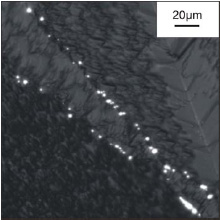Feb 16 2009
The electric breakthrough of solar cells cannot be ascribed to the surface preparation as has now been demonstrated by physicists at the University of Leipzig and the company Q-Cells SE in Bitterfeld-Wolfen. Innovative methods deliver images of the phenomena in previously unachieved spatial resolution. The results are published as a Rapid Research Letter in physica status solidi.
 Surface morphology with superimposed reverse bias
(–17V) electroluminescence from defects along grain
boundaries of a multi-crystalline silicon solar cell.
Surface morphology with superimposed reverse bias
(–17V) electroluminescence from defects along grain
boundaries of a multi-crystalline silicon solar cell.
Whatever absorbs light can also shine. Every student of thermodynamics knows this rule. Photovoltaics uses this principle whereby sunlight is absorbed and converted into electrical energy. Solar cells are implemented for this purpose, cells in which photo-electric voltage is generated which allows the flowing photo-electric current to do the work. This operating mode is called "forward bias".
When external current is fed into the solar cell in the direction of the forward bias, the solar cell begins to emit light (in the indiscernible infrared spectral range) analogous to the principle of a light-emitting diode. Defects in the material become immediately recognisable as dark areas since the light-emitting efficiency is lower in these areas than in the areas free from defects. Solar cells in the defective areas cannot produce a photocurrent when illuminated, and consequently cannot generate electricity.
Dominik Lausch from the Department of Semiconductor Physics at the Institute of Experimental Physics II grappled with this question. In his diploma thesis, he investigates solar cells to which he attached current flowing in the opposite direction, the so-called reverse bias. Here too, the solar cells show characteristic luminescence effects, yet they are exclusively on the defects, in particular on the grain boundaries contained in the multicrystalline material of his investigation.
A very sharp image of the luminescence emerges, an optical radiation through the transition
of electrons to a low-energy ground level state. "This makes it possible to locate and identify defects with a spatial resolution previously not known or achieved," says Marius Grundmann, Director of the Institute and head of the Department of Semiconductor Physics who supervises the work together with Kai Petter of Q-Cells SE.
The method established by the researchers is called ReBEL which stands for "Reverse Bias Electroluminescence". "The research findings underscore that photovoltaics are a sustainable and environmentally friendly technology", Petter notes with pleasure. "Our company, whose core business is developing, manufacturing and marketing efficient solar cells from mono and multicrystalline silicon, will benefit from this discovery."
Apart from this new analysis method for entire solar cells, the analysis of the reversebias region of solar cells also has an outstanding significance technologically. Under normal use, solar cells operate with forward bias. Yet if a shadow falls across a solar module, for instance falling leaves or shadows cast by a tree, the solar cells located in the shadow are suddenly under reverse bias.
If they cannot resist the voltage, then a strong current flows due to the effect of the electric "breakthrough". In this event, charge carriers typically are accelerated in a strong electrical field produced inside the diode within the solar cell. That generates new pairs of charge carriers and can thus lead to a high, and in the worst case uncontrollable current that can destroy the solar cell and the entire module.
The researchers have discovered that this breakthrough current arises only on certain defects and very locally. Moreover, its principal occurrence does not depend on the surface preparation of the solar cells with acidic or alkaline treatment which improves the solar cell’s absorption of light (anti-reflection coating).